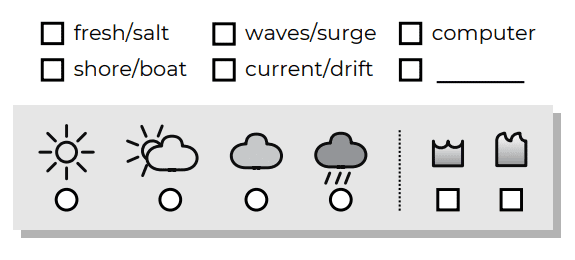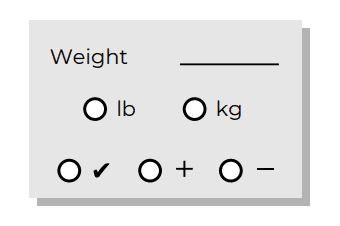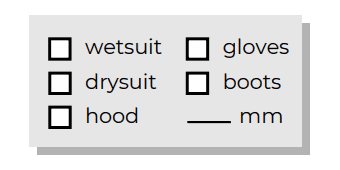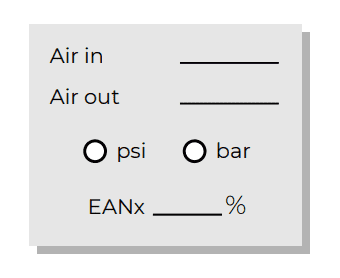The why, what and how of logging every dive (with free printable PDF)
When you started diving, you were probably eagerly logging every dive the minute you were back on dry land. But as time goes by, logging starts to feel more like an afterthought. You forget, or don’t feel like it. Why does it even matter to log? And what should you be writing anyway? In this article, we’ll look into why, what, and how you should be logging your dives, to get the most out of your dive log.
And there’s a bonus: at the end of the article is a downloadable free PDF template, so you can print your own logbook refills!
Why should you log your dives?
Logging dives helps you process the experience of your dive and enjoy it for a little bit longer. However, there are also very practical benefits to logging your dives. I’ll list the 7 of my best reasons to write in your logbook, but I’m sure most divers can give you several more.
1. Proving your track record
While a logbook is very personal, and isn’t in any way an official document, some dive shops and operators might ask to see your logbook. They will be looking at the amount of dives, where you’re dived and when you last dived, to get an idea of your experience level. Keeping track of your experience level will help you show what will and will not be a good fit for you.
2. Making memories
Several studies have shown that writing with pen and paper stimulate the brain to process thoughts more clearly. Having to think, process, and phrase properly what you experienced helps you solidify the memories of this particular dive. Furthermore, having the ability to go back and revisit those memories might not be something you’ll do daily, but something you might enjoy years from now.
3. Debriefing the dive
Most divers have probably been indoctrinated with the phrase “Plan your dive. Dive your plan”. Besides planning the dive and keeping the plan in mind, it is always a good idea to review the dive afterwards.
Especially when diving at beautiful sights or with stunning marine life, it’s easy to be preoccupied underwater. Sitting down with your dive computer and noting down the information in your log might make you notice things you missed: maybe you descended further than you should have following that shark? Now is the time to note that down and learn from it.
4. Recording dive sites
Chances are you’ll be diving when travelling. At the very least, I hope you do. Logging is a great way to remember those nice, but sometimes strangely named dive sites. Whether you’re ever going back there, or sharing some tips with your fellow divers, recording the dive site helps you remember what you saw where, when, and how.
5. Planning for future dives
Keeping track of where you dove, in what gear, and how that felt, will help you plan ahead for future diving. We’ll touch onto this more in the section what to log, but logging your exposure protection and the temperature, the weights you used with your gear, and the amount of air you used in a certain dive will help you create realistic expectations of future dives.
6. Lessons learned
Hopefully, you will continue to develop your diving skill. Whenever you try something new, figure something out, something felt good or bad, write it down! Over time, each of these lessons will help you become a better diver, by figuring out what works best for you.
7. Safety
I’ve put this reason last as it is the least fun one. However, I feel like it deserves a place on this list. If you happen to become unwell within a few days in a way that seems related to diving, it is crucial that health care providers can quickly get an overview of the diving you’ve been doing. This will help them to, for example, diagnose or rule out symptoms of decompression illness.
Bonus: 8. Collecting stamps

I know I said there were 7 good reasons, so here’s a bonus reason: keeping a logbook allows you to collect stamps from the dive buddies you meet and the dive operators you dive with. Make it a little competition between you and your buddies who can collect the most stamps!
What should you be logging?
So, hopefully you are convinced that there are many good reasons to log your dives. But, what exactly should you be logging and why? What’s the point of all this information?
1. Number, date, time and location

For obvious reasons, the when and where of a dive are important to remember. Include the name of the place or region, as well as the dive site name. If you’re diving multiple days in a row, most computers will show you the surface interval between this dive and the previous. Note this down as well, for your reference.
2. Conditions

What are the weather conditions like, how were the waves, the current? What was the water temperature? Was it salt or fresh? This kind of information will later say something about your experience, but might also affect, for example, what marine life you can see.’
3. Weight used

Beginning divers often struggle to estimate the amount of weight they will need. But by writing down how much weight you used, whether the water was salt or fresh, and what equipment you were wearing, you’ll have a reference to look up the amount of weight you’ll need for the next dive.
4. Equipment

What equipment are you using? Especially interesting if you’re used to diving in different gear.
Writing down the type and thickness of the wetsuit will help you develop a feel for the amount of protection you’ll need for each temperature. And by combining the thickness of the wetsuit and the weights used, you’ll get a better idea of the weights you need.
Logging the gear you were in, the sizes, and perhaps any likes or dislikes can help you figure out your preferences.
5. Depth and profile

Writing down the actual profile of the dive, or at the very least the maximum and average depth, will help you look at your air consumption. It will also tell you if you were diving within your limits and your plan. Finally, in case you’re not feeling well, this is helpful medical input.
6. Air consumption

In some areas I’ve dived, it was actually required by law to submit the dive times and the air consumption with the Coast Guard. While that may not be the case everywhere, this number is escpecially interesting for your dive planning and to help predict your consumption on future dives.
Based on your air consumption in a dive, you can calculate your Surface Air Consumption rate (or SAC-rate). Dividing your total air consumption by the length of the dive gives you the average consumption per minute. Dividing that number by the pressure at your average depth (1 at plus 1 at for every 33 feet, or 1 bar plus 1 for every 10 meters) gives you your equivalent usage at the surface, or your SAC-rate.
Collecting this number over multiple dives will give you a better idea of your consumption. For your next dive, you can multiply this number by the pressure at your expected average depth, to determine your air consumption at that depth. Dividing your tank pressure (minus some reserve) by that number will give you an estimate of how long you’ll be able to breathe at that depth as well.
7. Natural features and marine life
What did you see on your dive? This can be nice to remember later when revisiting a site, and to share your recommendatons with friends or fellow divers. If you’re taking pictures, this will also help you remember what that thing in the picture is and where you saw it!
8. Practiced skills and lessons learned
If you’re diving for a course, or have made any agreement with your buddy to practice and improve skills together, write about how that went and what you learned.
If you had an unexpected lesson, such as something going wrong or not feeling right? Write it down to make sure you learn from it the next time.
9. Computer warnings
Computers can give warnings for several reasons, and will generally beep annoyingly when they do so. However, it can still be that you’ve missed the alarm underwater. Write down any warnings you’ve received from your computer just in case, for example if you’ve ascended too quickly.
10. Buddy and dive operator
Who did you dive with? Who was your guide? What kind of group was it? Information like this can remember how it was diving with a specific person or a specific dive operator.
How to log your dives?
So, you know what to log and why to log it, but how do you do that? The most important part of logging is to make it a habit. Personally, I prefer to do it as soon as I can, when getting back on the boat or when I’m dried off and sitting in my car. That way, the details are still fresh in my mind and the log is most elaborate.
Additionally, the medium you use is an important part of your logging habit. It is important to find a way to log that is most convenient for you.
There are several ways to log digitally, ranging from special software that links to your dive computer, to dive logging apps, to simply typing your findings into a spreadsheet on your computer. There are many apps available online, which you can find with a simple Google search.
As I prefer logging on paper, I will not be able to recommend digital approaches. When it comes to paper logging though, there are also several options to consider:
- Logging in a bound booklet, like the PADI log that many of you may have started with.
- Using a common journal or notepad to write your notes without a template.
- Writing on a booklet that is inside a binder, or loose leafs that are inside a binder.
Bound log booklets
The benefits of logging in a bound booklet is the standardized template, which allows you to quickly note down the common pieces of information. They generally also use a heavier, somewhat waterproof, type of paper. The downside is the price point of such booklets, which is generally higher than I would expect.

Writing in a journal or notebook
While I don’t see it very often, it is of course also possible to write your logs in a good old journal or notebook that is not diving specific. While you do not have a template for your data, this gives some additional freedom, both in format and in size. In addition, they are often much cheaper.
Binders
Putting your log in a binder has several benefits: you’re able to put multiple booklets or loose leaf refills in one binder, they help keep your log in good shape, and often come with extra pouches or pockets, to keep small accessoiries, pens and your scuba certification cards. Additionally, you can often buy these binders with the logo of your dive operator, as a nice souvenir.
Personally, I use a binder that I bought on one of my trips. It contains the logbooks of my wife and myself, a few pens, our dive certifications and a few pens. In it, we have PADI log booklets, because we are used to them, but I’m considering printing my own refills when the booklet is full.
Bonus: free printable refill template
On the topic of printing your own refills, I’ve created a printable PDF template containing the information mentioned above. If you have a binder, printing it on slightly heavier paper, or having it printed at your local copy shop, will allow you to continue logging your dives for a fraction of the cost of expensive refills or booklets. I hope you enjoy it! If you have any questions, comments or feedback about the template, please let me know at reinier@thescubaneer.com.
